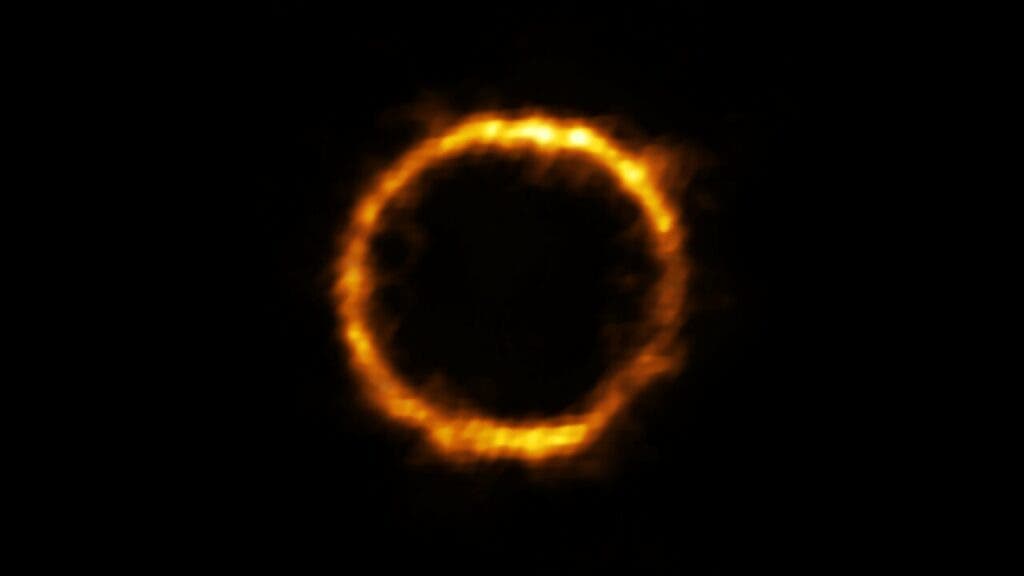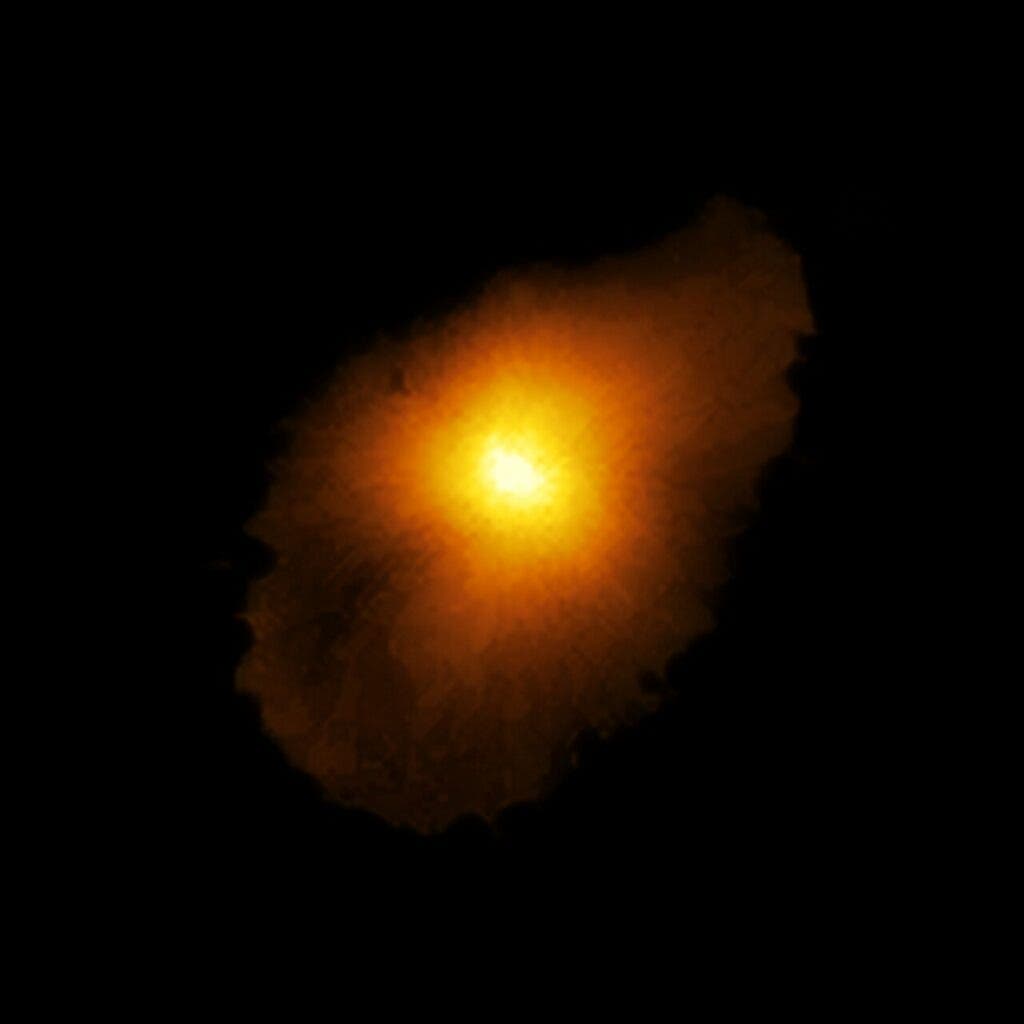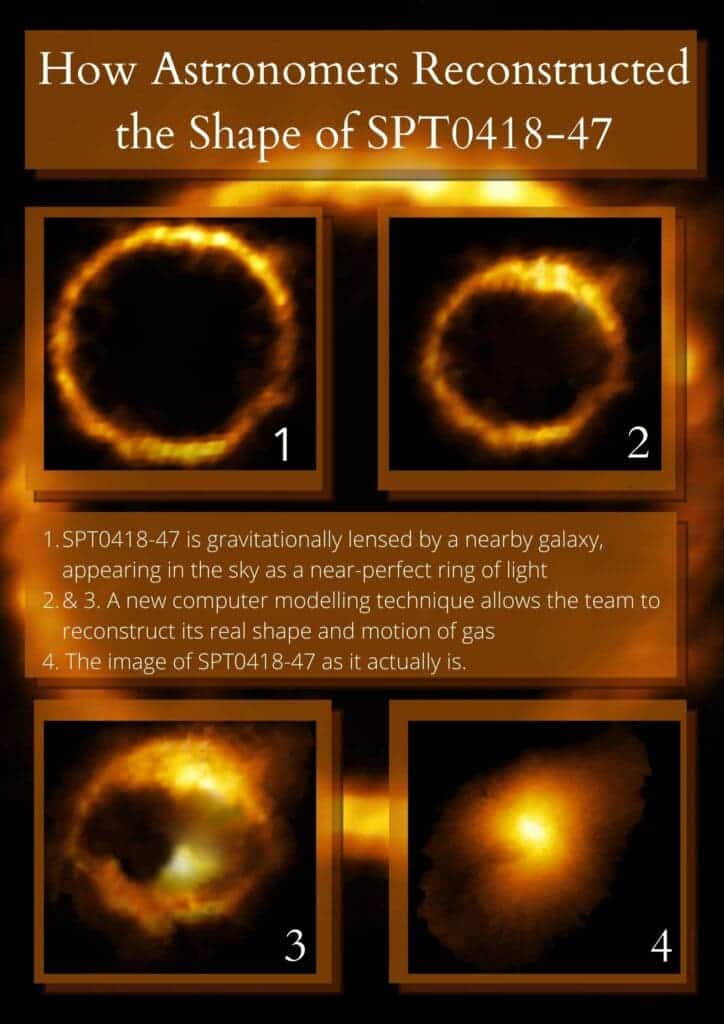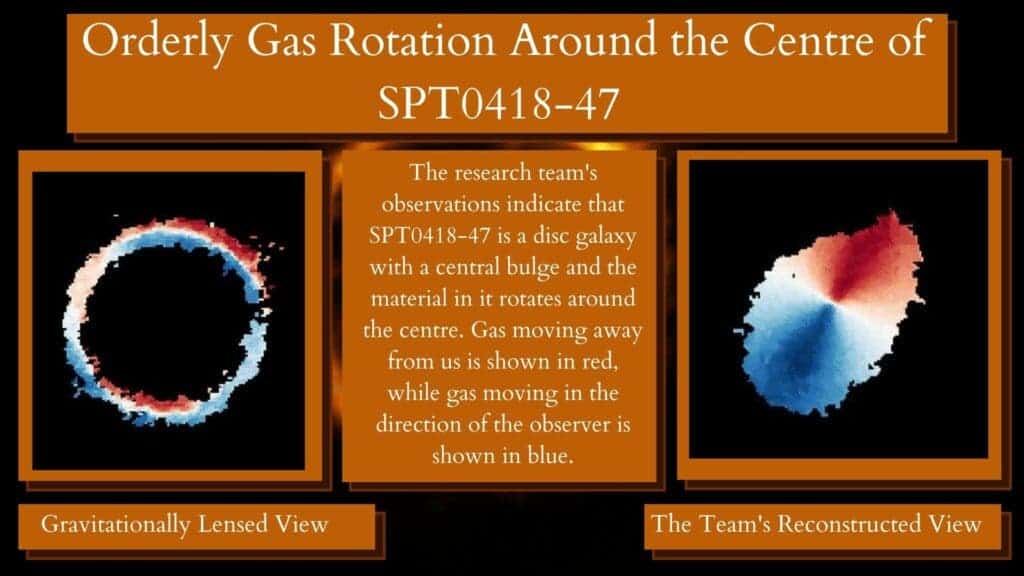Using the phenomenon of gravitational lensing astronomers have examined an extremely distant galaxy that shares many features with the Milky Way. The discovery of a calm galaxy so early in the Universe’s history calls into question our theories of how galaxies form.

(ALMA (ESO/NAOJ/NRAO), Rizzo et al.)
Astronomers have discovered that a distant young galaxy that existed in the very early universe shares some surprising similarities with our galaxy. The fact that the young galaxy named SPT-S J041839–4751.9 or SPT0418–47 for short — located 12 billion light-years from Earth — resembles the Milky Way and the galaxies that surround it presents something of a problem. Galaxies that existed 1.4 billion years after the Big Bang, weren’t supposed to be so calm, unchaotic, and well-formed.
Thus the discovery of this throws many of our theories of galactic evolution into question. In fact, this finding fits into a series of recent discoveries that suggest galaxies began forming much earlier in the Universe’s history than previously believed.

(ALMA (ESO/NAOJ/NRAO), Rizzo et al.)
“This result represents a breakthrough in the field of galaxy formation, showing that the structures that we observe in nearby spiral galaxies and in our Milky Way were already in place 12 billion years ago,” says Francesca Rizzo, a PhD student from the Max Planck Institute for Astrophysics in Germany, and the lead author of a paper detailing the findings published today in the journal Nature.
Whilst the observation of this distant galaxy would not have been possible without the impressive technology of the ESO’s Atacama Large Millimeter/submillimeter Array (ALMA) located in the Chilean Andes, it also hinged on the invention of another galaxy, and an extraordinary feature of Einstein’s theory of general relativity. The team reconstructed the accurate image of SPT0418–47 from the ring-like image received by ALMA as a result of gravitational lensing by an intervening galaxy.
“We have studied in great detail a very distant galaxy. This means going back in time and we see this galaxy when it was very young, 1.4 billion years after the Big Bang,” Rizzo’s co-author, Filippo Fraternali, from the Kapteyn Astronomical Institute, the University of Groningen, Netherlands, tells ZME Science referring to the fact that the light from SPT0418–47 has travelled 12 billion years to reach us.
“Given that galaxies cannot form right after the Big Bang, we can estimate that SPT0418–47 [as we see it] is about 1-billion-years old.”
A Distant Milky Way Doppelganger With Some Key Differences
SPT0418–47 possesses a central bulge and a rotating disc, two features also displayed by the Milky Way and other local galaxies. However, it lacks the Milky Way’s spiral arms and is also much smaller than our home galaxy. This is the first time that astronomers have spotted a central bulge — stars tightly clustered around the galactic centre — in such a distant, and therefore early, galaxy.
However, Fraternali notes that just because SPT0418–47 resembles the Milky Way at the stage we see it at, that doesn’t mean it evolved just as our galaxy did. “It is important to remark that whilst SPT0418–47 is similar to the Milky Way now, it does not mean that 12 billion years ago the Milky Way looked like SPT0418–47,” the researcher adds.
“In fact, we think that SPT0418–47 will evolve into a galaxy very different from the Milky Way, an elliptical galaxy, much more massive and without gas.”

Another key difference between the two galaxies is that SPT0418–47 is forming stars much more rapidly, unusual for a rotating disk. “SPT-S J041839–4751.9 belongs to a particular population of galaxies that are known as dusty star-forming galaxies,” Simona Vegetti, another co-author on the paper and an expert in gravitational lensing from the Max Planck Institute for Astrophysics, tells ZME Science. “As the name suggests, these are galaxies that are undergoing a significant burst of high-rate star formation.”
Vegetti goes on to explain that astronomers believe that as they age, galaxies like SPT0418-47 will turn into what is referred to as early-type galaxies — a galaxy which has consumed most of its gas and is not forming stars anymore.
“By comparing the properties of SPT-S J041839–4751.9 with those of nearby early-type galaxies, we can learn something about the processes which are responsible for the transformation from one galaxy type to the other,” shes says. “It’s a bit like comparing the properties of young and old people, it gives us some hints on the ageing process.”
But the most puzzling aspect of the distant galaxy is how calm and ordered it appears. Something current cosmological models cannot account for.
Young and Chaotic?
Our current cosmological models suggest that the Universe that SPT0418–47 as we see it inhabited was a chaotic and turbulent place. And galaxies found during this epoch are expected to reflect these qualities, even if they do possess some structure, this should be washed out by the violent conditions around them.
“The general idea was that galaxies at those distances/times were extremely chaotic and one would barely recognise a disc in formation in amongst massive filaments of infalling gas and powerful explosions due to the extremely intense star formation,” says Fraternali.
Galaxies in the early universe are expected to be the site of powerful phenomena like supernova explosions which release a lot of energy Vegetti explains, adding: “We would expect SPT-S J041839–4751.9 to be very turbulent, or in other words, we expect the motion of gas in this galaxy to move chaotically in winds and outflows.”
But the team’s observations reveal a completely different picture. What they actually found was that the motion of the gas in SPT0418–47 is, in fact, rotating around the centre of the galaxy quietly and in a well-ordered fashion. As Vegetti notes: “It is very hard to explain this behaviour within the context of the latest state-of-the-art numerical simulations of galaxies.”

One of the man questions that remain for Fraternali is how common are these features and the relatively ‘calmness’ of SPT0418–47 in other older galaxies? “Because the galaxy has not been selected by us — it was, by chance, perfectly aligned with the lens along the line of sight — we may argue that it could be representative of a large fraction of massive galaxies at that time.”
Thus, staring back in time to conduct further investigation of these distant stars is of vital importance. But, that, as you may imagine, is no easy task. In fact, the study of SPT0418–47, as Fraternali indicates, was only made possible by the intervention of another galaxy coming between it and us, and the ensuing remarkable phenomena of gravitational lensing.
Galaxies as Lenses — the Power of Gravitational Lensing
The exact alignment of SPT0418–47 and an intervening galaxy means that it appears as a near-perfect ring to the team at ALMA — a structure referred to by astronomers as an ‘Einstein ring’ by astronomers due to its connection to the theory of general relativity — the geometrical theory of gravity put forward by Einstein in the early years of the 20th Century.
Gravitational lensing hinges on the fact that objects with mass curve the fabric of spacetime around them. The greater the mass, the more extreme the curvature. The most common analogy used to describe this is a stretched rubber-sheet having objects of increasing mass placed on it. A bowling ball creating a greater ‘dent’ on the sheet than a marble or a tennis ball.
This means that an object like a galaxy with tremendous mass curves the path of light travelling past it, often this results in an object behind the lens appearing to be located in a different place. In extreme cases, creating an ‘Einstein Ring’ built up of light that took different curved paths around the intervening galaxy and thus arrived at Earth at slightly different times. But, isn’t just a beautiful and curious phenomenon of gravity, it’s also a powerful observational tool.

“Because these galaxies are very far, it is challenging to study them in great detail using current telescopes, they are not powerful enough,” Vegetti says. “Our team then uses the effect of strong gravitational lensing to overcome this limitation.”
The process used by the team first involves the search for a pair of galaxies that are far away from each other but appear aligned from our vantage point here on Earth. “The galaxy closer to us will then behave like a lens providing us with a magnified view of the more distant galaxy,” Vegetti elaborates. “It’s like observing through a much more powerful telescope.
“When we started studying this object we had no idea of what we were going to find. There are almost no other studies of galaxies so young at such a level of detail.”
Vegetti explains that the next generation of telescopes such as the James Webb Space Telescope and the ESO’s Extremely Large Telescope (ELT) should allow for the study of SPT0418–47 galactic contemporaries in much greater detail. This will allow researchers to discover just how common these features are, and in turn, possibly spark a rethink of how early well-ordered galaxies could form in the Universe’s history. She also reserves special praise for this study’s lead author.
“These new facilities will bring this type of analysis to the next level, allowing us to observe even younger galaxies with an even greater level of detail,” Vegetti concludes. “Francesca Rizzo is leading the way in this line of research. She is a brilliant young scientist with whom I enjoy working, so I am looking forward to our next discovery!”
Source
Rizzo. F., Vegetti. S., Powell. D., Fraternali. F., et al, ‘A dynamically cold disk galaxy in the early Universe,’ Nature, [2020].






